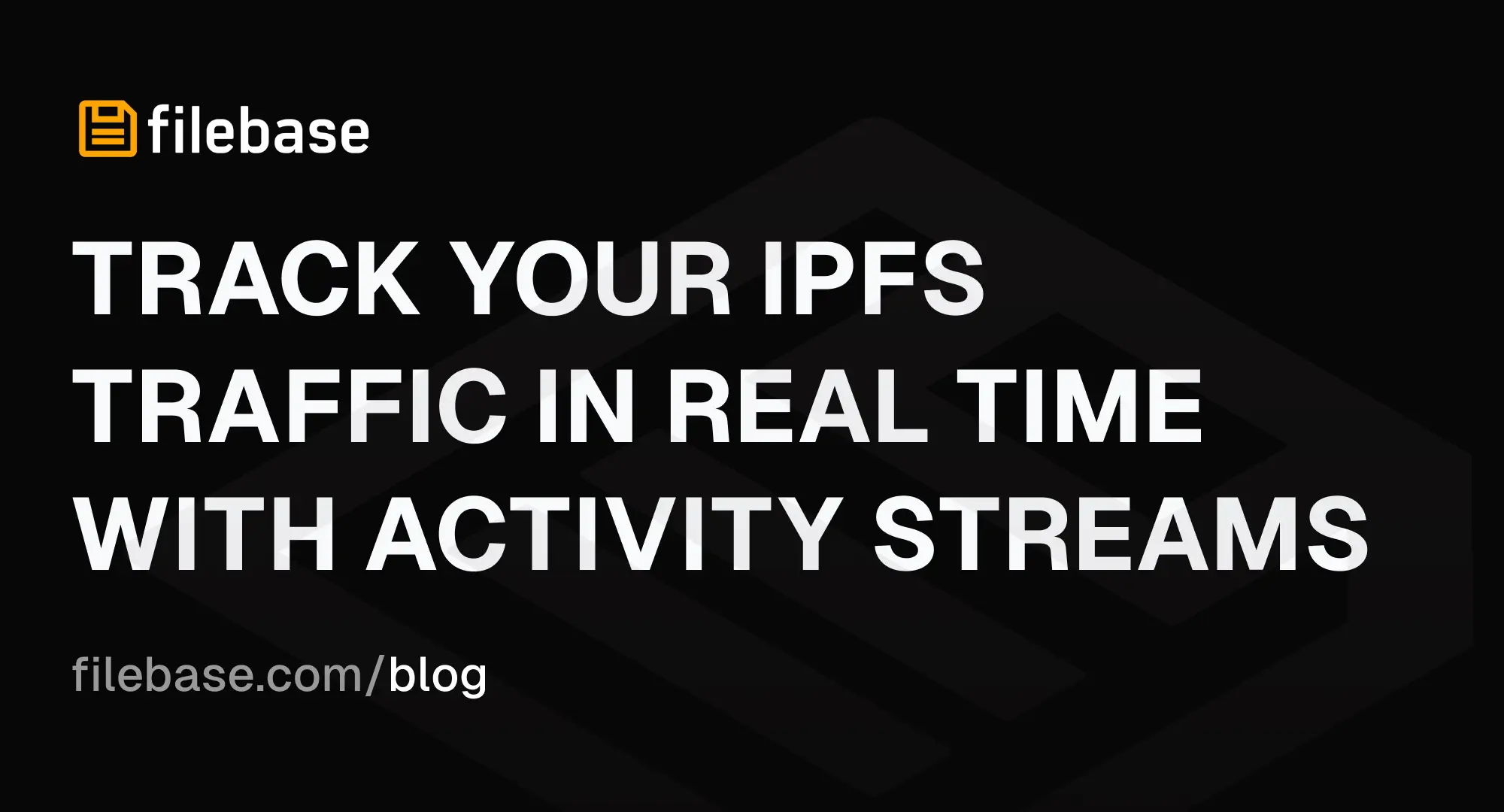Track Your IPFS Traffic in Real Time with Activity Streams
Public IPFS gateways are easy—but blind. Filebase’s Activity Streams give you real-time, per-request visibility into your IPFS traffic.

Most developers know the basics of IPFS. It’s a decentralized protocol, it’s content-addressed, and it’s ideal for censorship-resistant hosting. But when it comes to actually serving content—especially to end-users via the web—you’re going to use a gateway.
So: which kind? Public or dedicated? And more importantly—what happens when you need insight into what’s actually happening with your IPFS-hosted content?
Let’s break down the tradeoffs—and why Filebase’s Gateway Activity Streams tilt the balance heavily in favor of dedicated IPFS gateways.
Public Gateways: Great for Browsing, Bad for Observability
Public IPFS gateways (like ipfs.io or dweb.link) are essentially the freeways of the decentralized web. Anyone can use them. No setup, no keys, no account.
If you’re just linking to a CID on Twitter, or testing a new app build, a public gateway is fine. But they fall apart fast when you care about:
- Reliability: These are shared resources. If traffic spikes, expect slowdowns.
- Rate limits: Gateways throttle heavy usage to prevent abuse.
- Uptime: No SLAs, no guarantees. If it’s down, you’re out of luck.
- Observability: There’s no way to know how or when your content is accessed.
That last one matters more than it seems. Without insight into access logs or request patterns, you're flying blind. For production use? That's a non-starter.
Dedicated Gateways: IPFS With Control, Performance, and Monitoring
Dedicated IPFS gateways flip the model. These are provisioned per user or project (like on Filebase), and they offer:
- Your own endpoint (e.g.
ipfs.myproject.com) - Consistent performance (backed by CDN)
- HTTPS + custom domain support
- Higher rate limits (or none)
- Optional access controls
But most importantly: you get visibility.
With Filebase, that visibility comes through real-time Activity Streams—a unique feature that gives you a live feed of every HTTP request to your dedicated gateway.
It’s not just logging. It’s observability built into the gateway fabric.
What Are Activity Streams, Exactly?
Think of Activity Streams like an API request console—but for your IPFS content.
Every request to your Filebase IPFS Gateway shows up instantly in your browser:
- Timestamp
- HTTP method (GET, HEAD)
- Response code (200, 404, etc.)
- IP address of the requester
- Hostname (your domain or subdomain)
- Requested URI
- Bytes served
This is live, streamed via WebSocket, with virtually zero delay. You click a CID, refresh your dApp, run an NFT reveal—you see the request hit your gateway in real time.
It’s powerful. And it’s only possible because Filebase runs its own CDN infrastructure—no third-party middleware, no black-box routing.
Why Activity Streams Matter
🧠 Understand Usage at a Glance
Who’s hitting your content? When? From where?
Whether you’re hosting a public NFT gallery, a DAO dashboard, or a static IPFS website, Activity Streams help you answer those questions with zero setup. It’s observability baked in.
🚨 Spot Issues Before Your Users Do
Got a 404 popping on an important file? You’ll see it instantly. Filebase logs request failures right next to successful ones, so you can catch typos, broken CIDs, or routing issues before your community does.
🛡️ Monitor for Suspicious Traffic
See an unusual spike in requests from one IP? Repeated hits on a deprecated CID? Now you can catch those patterns early—before they become a problem.
🔎 Validate Launch Traffic in Real Time
Launching a new drop? Pushing out an app update?
Filebase’s Activity Streams give you an instant pulse on traffic. It’s like having tail -f for your IPFS content—perfect for watching live launches, identifying bottlenecks, or proving SLA compliance.
Why You Won’t Get This With Public Gateways
Public gateways are shared. You don’t control them, and you don’t get access to logs. Even if a public gateway could technically surface traffic data, it wouldn’t make sense—every request would be mixed with thousands of others, across projects.
That makes Activity Streams fundamentally incompatible with the public model. You need a dedicated endpoint—like what Filebase provides—to get per-user, per-domain request data that actually means something.
Filebase: IPFS Hosting With First-Class Observability
Filebase doesn’t just pin your content—it serves it via production-ready, CDN-backed ipfs gateways with developer tooling that goes way beyond “upload and hope.”
With Activity Streams, you get:
- A live, request-by-request view of all gateway traffic
- Zero-latency updates, streamed straight to your browser
- Visibility into every CID access, domain hit, and request pattern
- A transparent window into your dApp’s most critical delivery layer
Coming soon: a full Analytics dashboard with persistent history, export options, and deeper insights.
Final Thoughts: When Visibility Matters, Public Just Doesn’t Cut It
IPFS is great. But the difference between serving content and monitoring content is the difference between a hobby project and a real application.
If your project depends on performance, observability, or uptime—Filebase’s dedicated IPFS gateways with Activity Streams give you the edge. You don’t just serve content. You track it. You debug it. You understand it.
Ready to see your IPFS traffic in real time? Try Filebase’s Activity Streams
Reliable IPFS, Zero Headaches
Gateways, IPNS, and seamless pinning—all in one place. Try it now
Get Started For Free!